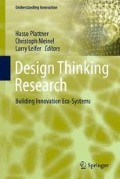Abstract
The impact and sustainability of creative capacity building over time is examined using both neural and psychological approaches. Our research proposes a unique experimental design to test whether creativity can be acquired or learned by an individual over time and how this relates to cognition, behavior, and the brain. In this chapter, we review the background work that focuses on specific cognitive, behavioral, and neural processes that may contribute to creative capacity building. We summarize key components of our experimental design, overview its implementation, and preview early outcomes of intervention research as it relates to the creative capacity building.
Access this chapter
Tax calculation will be finalised at checkout
Purchases are for personal use only
References
Abraham A, Pieritz K, Thybusch K, Rutter B, Kröger S, Schweckendiek J et al (2012) Creativity and the brain: uncovering the neural signature of conceptual expansion. Neuropsychologia 50(8):1906–1917
Angel R, Everson G (1985) Pictionary. Angel Games, Inc for fist edition. Current Publisher, Hasbro
Ansburg PI, Hill K (2003) Creative and analytic thinkers differ in their use of attentional resources. Pers Individ Differ 34:1141–1152
Arden R, Chavez RS, Grazioplene R, Jung RE (2010) Neuroimaging creativity: a psychometric view. Behav Brain Res 214(2):143–156
Aziz-Zadeh L, Liew S-L, Dandekar F (2013) Exploring the neural correlates of visual creativity. Soc Cogn Affect Neurosci 8(4):475–480
Benedek M, Franz F, Heene M, Neubauer AC (2012) Differential effects of cognitive inhibition and intelligence on creativity. Pers Individ Dif 53(4):480–485
Bott NT, Kienitz E, Quintin EM, Saggar M, Hawthorne G, Royalty A, Reiss AL (April 2013) Creativity training enhances self-directed attention and information processing. Poster presentation at the Cognitive Neuroscience Society Annual Meeting. San Francisco
Carson SH, Peterson JB, Higgins DM (2005) Reliability, validity, and factor structure of the creative achievement questionnaire. Creat Res J 17(1):37–50
Costa PT, McCrae RR (1992) Manual of the revised NEO personality inventory. Psychological Assessment Resources, Odessa
Costa PT, McCrae RR (2010) NEO five-factor inventory-3. Psychological Assessment Resources, Lutz
de Acedo S, Baquedano MT, de Acedo S, Lizarraga ML (2012) A correlational and predictive study of creativity and personality of college students. Span J Psychol 15(3):1081–1088
Delis DC, Kaplan E, Kramer JH (2001) Delis–Kaplan executive function system. Pearson Education, San Antonio
Dietrich A, Kanso R (2010) A review of EEG, ERP, and neuroimaging studies of creativity and insight. Psychol Bull 136(5):822–848
Fink A, Koschutnig K, Benedek M, Reishofer G, Ischebeck A, Weiss EM, Ebner F (2012) Stimulating creativity via the exposure to other people’s ideas. Hum Brain Mapp 33(11):2603–2610
Funrnham A (1999) Personality and creativity. Percept Mot Skills 88(2):407–408
Green AE, Kraemer DJM, Fugelsang JA, Gray JR, Dunbar KN (2012) Neural correlates of creativity in analogical reasoning. J Exp Psychol Learn Mem Cogn 38(2):264–272
Jung RE, Grazioplene R, Caprihan A, Chavez RS, Haier RJ (2010a) White matter integrity, creativity, and psychopathology: disentangling constructs with diffusion tensor imaging. PLoS One 5(3):e9818
Jung RE, Segall JM, Jeremy Bockholt H, Flores RA, Smith SM, Chavez RS, Haier RJ (2010b) Neuroanatomy of creativity. Hum Brain Mapp 31(3):398–409
Kern B (2010) What chief executives really want. Bloomberg businessweek. Bloomberg L.P., New York
Kienitz E, Bott NT, Quintin EM, Saggar M, Hawthorne G, Royalty A, Reiss AL (April 2013) Creativity training enhances creative persistence and increased abstract connections. Poster presentation at the Cognitive Neuroscience Society Annual Meeting. San Francisco
Kim KH (2008) Meta-analyses of the relationship of creative achievement to both IQ and divergent thinking test scores. J Creative Behav 42(2):106–130
Linked in (2011) http://blog.linkedin.com/2011/12/13/buzzwords-redux/?trk=corpblog_1212
Takeuchi H, Taki Y, Sassa Y, Hashizume H, Sekiguchi A, Fukushima A, Kawashima R (2010) White matter structures associated with creativity: evidence from diffusion tensor imaging. Neuroimage 51(1):11–18
Takeuchi H, Taki Y, Hashizume H, Sassa Y, Nagase T, Nouchi R, Kawashima R (2012) The association between resting functional connectivity and creativity. Cerebral Cortex 22(12):2921–2929
Torrance EP (1974) The torrance tests of creative thinking-norms-technical manual research edition-verbal tests, forms A and B- figural tests, forms A and B. Personnel Press, Princeton
Vartanian O, Martindale C, Kwiatkowski J (2007) Creative potential, attention, and speed of information processing. Pers Individ Dif 43:1470–1480
Wechsler D (2011) The Wechsler abbreviated scale of intelligence, 2nd edn. Pearson Education, San Antonio
Wolfradt U, Pretz JE (2001) Individual differences in creativity: personality, story writing, and hobbies. Eur J Pers 15(4):297–310
Author information
Authors and Affiliations
Corresponding author
Editor information
Editors and Affiliations
Rights and permissions
Copyright information
© 2014 Springer International Publishing Switzerland
About this chapter
Cite this chapter
Hawthorne, G. et al. (2014). Impact and Sustainability of Creative Capacity Building: The Cognitive, Behavioral, and Neural Correlates of Increasing Creative Capacity. In: Leifer, L., Plattner, H., Meinel, C. (eds) Design Thinking Research. Understanding Innovation. Springer, Cham. https://doi.org/10.1007/978-3-319-01303-9_5
Download citation
DOI: https://doi.org/10.1007/978-3-319-01303-9_5
Published:
Publisher Name: Springer, Cham
Print ISBN: 978-3-319-01302-2
Online ISBN: 978-3-319-01303-9
eBook Packages: Business and EconomicsBusiness and Management (R0)

